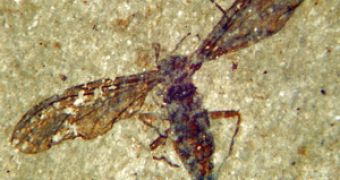The reason why this discovery is so huge is simply because it's the first of its kind. In other words, it's the first full-body impression of a prehistoric fly, dating as far back as 300 million years ago. According to paleontologists, the fossil belongs to the Carboniferous Period. Most amazing are the circumstances under which this impression of the fly on the soil occurred. All those years ago, a fly minding its own business landed on a piece of soft, moldy clay and left its mark on the future.
Scientists Richard J. Knecht and Jake Benner "stumbled" upon the fossilized impression while they were digging at a site mentioned in a 1929 master paper. The place was a wooded field in North Attleboro, Mass., near a strip mall. It's ironic that most paleontologists seek out fossils in the most remote places, where humans barely made their presence felt. The fact that the American scientists discovered the fossils in such an unlikely area only goes to show the distribution that these animals had throughout the world.
By analyzing this new find, archaeologists hope to find out more data about this type of insect, including its behavior, its patterns of motion when it landed, as well as further anatomical background for its torso and legs. These pieces of information could help evolutionary biologists better understand how modern-day insects evolved from their ancestor, what features they kept, which were lost and, most importantly, why.
No doubt, adaptation forced major physical changes in all living creatures over the course of millions of years, but that only happened because larger animals apparently never had what it took to survive. Knecht and Benner say that the impression they found showed no evident traces that the insect had wings, but based on its position and the fact that there were no leg marks leading to the section of the rock it was discovered in, they concluded that the creature could only have come from above.
"Once we pin down what type of insect it is we can begin to think about the conditions, the climate and life that must have existed in the environment to support its life. One focus is the insect itself. Another is the broader big picture of the world it lived in," Knecht concluded.

 14 DAY TRIAL //
14 DAY TRIAL //